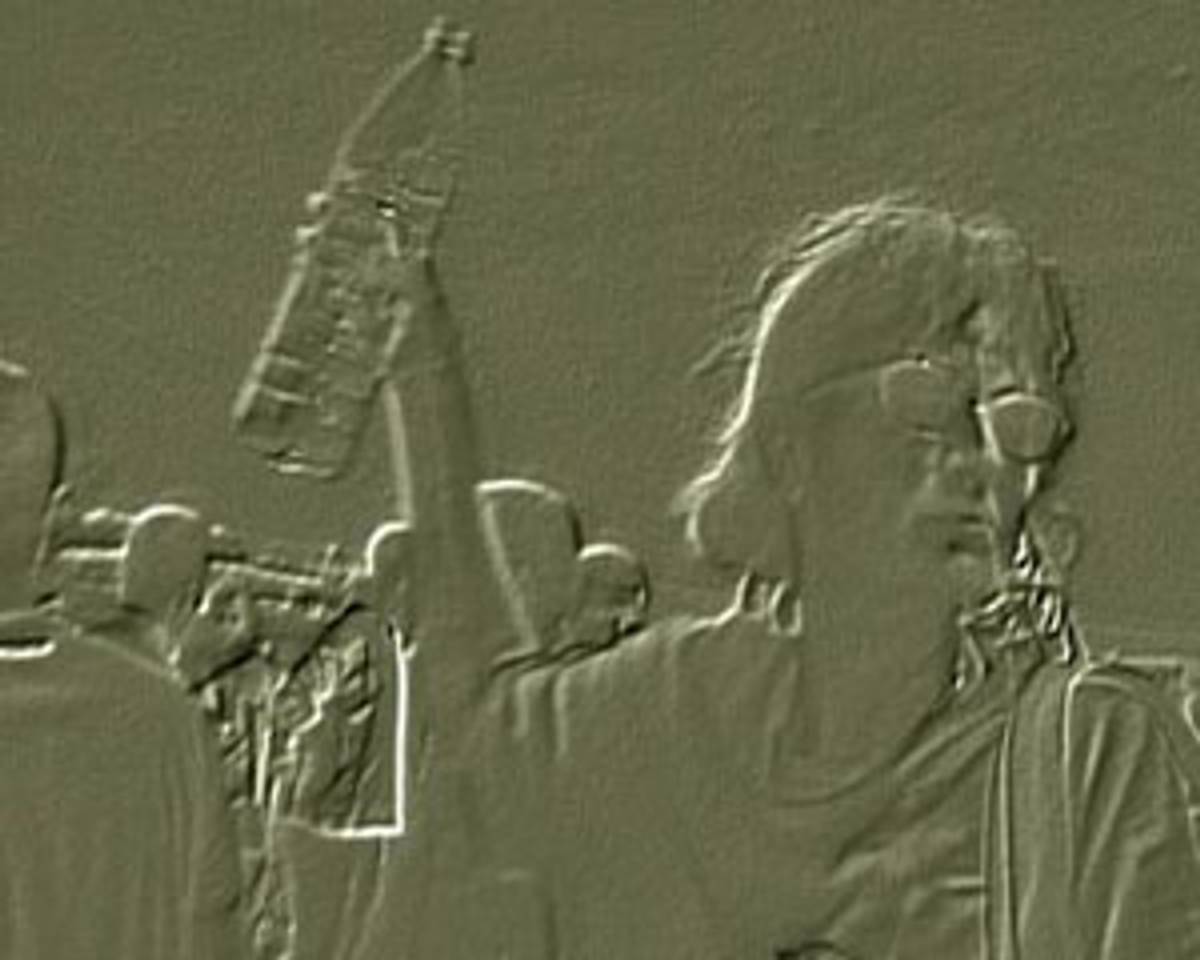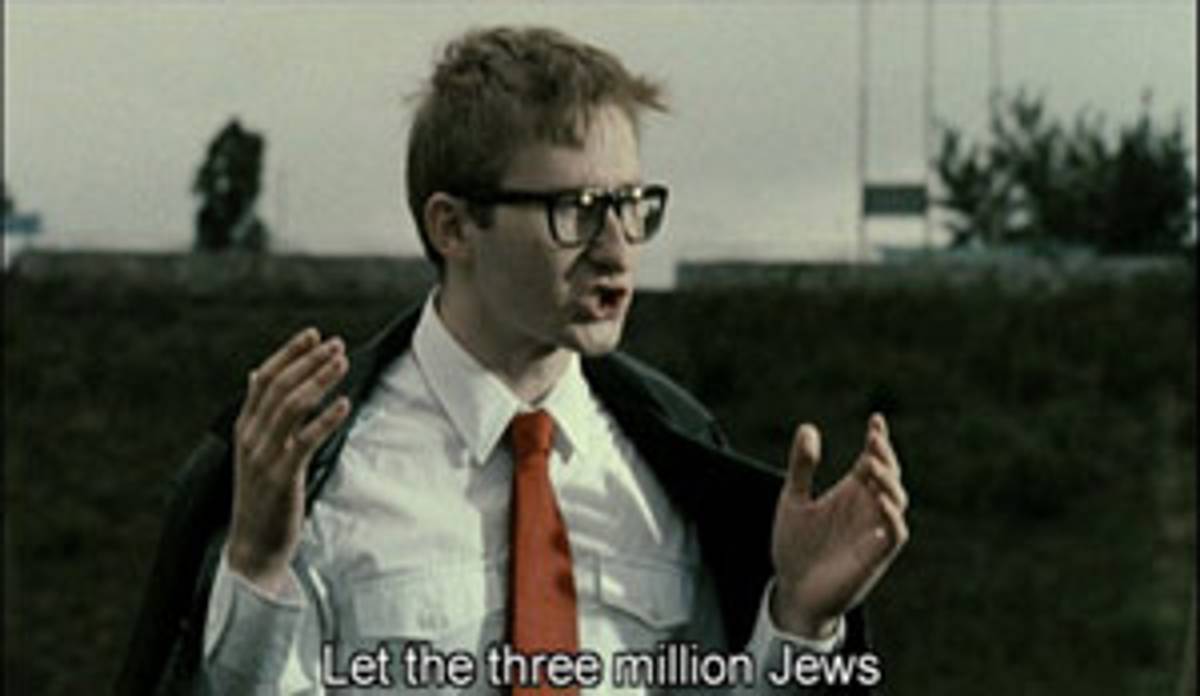There is a limit to the recognition—and, therefore, funding and critical support—an artist can achieve in a small town or country. That’s why artists still flock to large art centers like New York, Berlin, or Beijing. The situation is doubly complicated for young Israeli artists. Their ancestors fought for a Jewish state; the goal was to end up in Israel, not leave it.
These issues are central for Yael Bartana, and not just as part of her biography. Bartana was born in 1970 in Afula, a town in the lower Galilee which, because of its proximity to the West Bank, has seen its share of violence. After graduating from the Bezalel Academy of Arts and Design in Jerusalem in 1996, Bartana earned an MFA at the School of Visual Arts in New York, then studied at the Rijksakademie in Amsterdam. She currently divides her time between Israel and Amsterdam.
Bartana is working in a medium that has been embraced by many young Israeli artists: video. Artists like Guy Ben-Ner, Tamy Ben-Tor, and Sigalit Landau have gained international recognition for their video work, which has dealt variously with history, identity, modernism, and the Holocaust. “It’s a very good tool for dealing with reality,” Bartana says. “It’s very immediate: you have the sound and the image. You can document, but also become an intermediary.”
Her own videos are intricately engaged with issues of cultural identity and the Jewish state. Speaking by phone on the eve of the opening of her show at P.S. 1 in Long Island City (her first solo exhibition in New York), Bartana says that she comes from a “very Zionist” family, but “wasn’t raised religious. For me, all of this is more about cultural identity than religion.”
Living abroad provided the critical perspective Bartana needed to look back at her homeland. “The politics and the culture of the United States are more connected with Israel,” she explains. “But I felt different in Europe.” Her experiences there gave her the distance she needed to make some return visits to Israel, and make art that probed deeper into the complexities of the nation from which she came.

In the show at P.S. 1, five videos Bartana created since 2001 are arranged in three darkened rooms. The earlier ones are oblique, poetic, and metaphoric. Trembling Time (2001) uses footage shot at night on Memorial Soldiers Day, from an overpass in Tel Aviv. In the video, a stream of cars comes to a sudden stop in the middle of a highway, and people get out to observe a national moment of silence in commemoration of fallen soldiers. By manipulating the documentary footage—mostly through slow motion, but also by fading images into each other—Bartana has made the cars and people look like eerie apparitions.
Documentary footage also serves as the springboard in Kings of the Hill (2003). Here, men drive their trucks and sport utility vehicles along a stretch of ground near the Mediterranean sea, an otherworldly landscape that becomes rutted as the vehicles climb up and down the red, sandy ground. The title and the absurd maneuverings of the vehicles driving “off-road”—but in a relatively constricted area—bring to mind childhood games, but the resonance is particularly poignant in Israel. King of the Hill, after all, is a zero-sum game: there can be many competitors, but only one winner; the object is to capture a piece of ground and hold onto it.
There’s also an undeniable sense of machismo in Kings of the Hill, with the men aiding and cheering each other on as they conquer the slopes. Bartana owns this. “Some people put me in the feminist camp. For me, it’s just the way I’m looking at masculinity in Israel.” (Like most young Israelis, Bartana performed her compulsory military service, which put her at the center of what she calls “this masculine, militant culture.”) Rather than explore those ideas further, however, she is increasingly turning in a different direction: resistance. “Now I’m more interested,” she says, “in showing how communities resist authority.”

Low Relief II (2004) was a tentative step in that direction. The four-channel video—resulting in four projections on the wall—captures protesters wrangling with policemen, but the images are manipulated to look like ancient low relief sculpture. There’s something about this strategy that both cloaks and reveals Bartana’s incendiary subject matter: we can see the action and the figures, but the drab monochrome muddies the distinctions between people, landscape, and opposing factions. But in her most recent videos, the gloves are off. Wild Seeds (2005) takes as its subject a group of young people wrestling playfully on a grassy hilltop. The young people, however, are actually pacifists playing a game in which teams either take on the roles of soldiers, or of settlers being forcibly removed from their homes in the Occupied Territories. A video projected on the adjacent wall functions as subtitles, with text like “where is your conscience? This is our land!” and “traitor!”
The conflicts in Israel among its inhabitants is also the subject of Summer Camp, a video that was screened at the prestigious Documenta 12 exhibition in Kassel, Germany in the summer of 2007. Installed in a wood-paneled room at P.S. 1, the video opens with a shot of an arid landscape and the word “Palestine.” People doing construction work on a house appear. Rather than just building, it turns out that they are rebuilding: they are activist volunteers working with the Israeli Committee Against House Demolitions (ICAHD) to rebuild a Palestinian home demolished by the Israeli government in the resettlement plan.
Bartana says that even though the whole thing looks a bit like an archeological dig, she thinks of it in terms of a different science: “It’s more like anthropology and how society creates identities. I’m not so into theories. I’m interested in the contradictions between the subjects I’m seeing and the landscape.” Here, that means the land which was “built” (or “reclaimed”) by Zionists and is now being reconstructed, for Palestinians, by descendants of the original settlers (among other volunteers).
Summer Camp appears on a screen set up in the middle of the room, dividing the space in two. On the other side of the screen, another film is running. The similarities between the two are inescapable: this one also opens with the word “Palestine” and shows people working, building, and harvesting land. Turns out it’s an old propaganda film, Avodah (which can be translated as “work,” but also refers to offering ancient sacrifices) from 1935, directed by the photographer Helmar Lerski. Bartana used this film about early Jewish settlers as a template for her own, whittling it down to twelve minutes and sampling from the soundtrack. But where Avodah ends with the image of an Israeli flag—or a version of it, since this is pre-Israel—Summer Camp ends with a very different, unsettling image: an armored Israeli military vehicle driving away from the camera.
The idea of utopian politics and propaganda is everywhere in the Summer Camp installation. Bartana explains the connection: “I’m very interested in art from the 1930s, particularly Russian Constructivist films. Eisenstein: he’s my hero.” She’s referring, of course, to Sergei Eisenstein, the famous Soviet Russian film director whose silent films Strike, Battleship Potemkin, and October chronicled events surrounding the Russian revolutions of 1905 and 1917.

But Bartana’s interest in propaganda films extends into even more complicated territory. A video not on view at P.S. 1, Mary Koszmary, which premiered at the Centre Pompidou in Paris last November, was shot in the Warsaw Stadium and features a young leftist writer and politician, Slawomir Sierakowski, giving a speech—to a near empty stadium—calling for the return of Jews to Poland. The video is based on the policies and charters written up by medieval Polish princes, which favored Jews because of the cultural and economic benefits they felt they could bring Poland. It ends with children in scout uniforms laying down large stencils on the green turf of the stadium, spelling out the central point of Sierakowski’s speech: “3,300,000 Jews can change the life of 40,000,000 Poles.”
Just as important, Bartana’s video clearly references the work of Leni Riefenstahl, the notorious German filmmaker whose Triumph of the Will depicted Nazis at the 1934 Nuremberg Rallies. To be an Israeli admirer of Riefenstahl is complicated, as Bartana acknowledges. “It’s the language she developed,” she explains. “But it’s not only her; it’s this period that interests me and the relationship between making art and dictatorships.”
The questions raised by Bartana’s videos are among the stickiest in contemporary geopolitics: What happens when Jews become kings of the hill? What is the fate of Israel? How should Bartana’s generation’s act or respond to the current crisis? Speaking with writer Joshua Mack in Tel Aviv last year, Bartana commented that what’s happening in her homeland “feels to me like the end of Zionism.” (When asked about this now, she deflects the question, laughing, “I hope my parents don’t read that!”) Comparisons of Zionism to the Soviet Union—and worse, Nazi Germany—are provocative and chilling. Yet, Bartana does not shirk from drawing some of the toughest, most unflattering parallels in her work.
Meanwhile, the show at P.S. 1 opened just a few weeks before the American presidential election. Bartana, who is also currently in a group show at the New School called “Democracy in the Age of Branding,” is sticking around to see what happens. “It’s an important time for the American nation—for the world—and I want to be here,” she says. One senses that, in the barrage of propaganda leading up to November 4th, she’ll also find some kernel of inspiration for a future video.